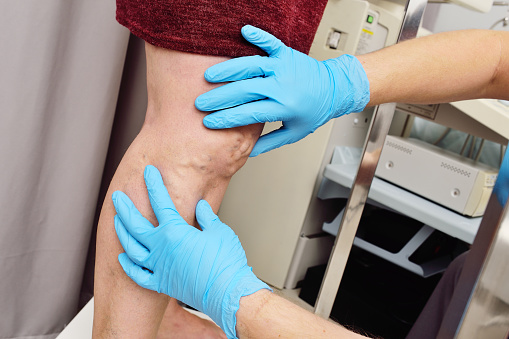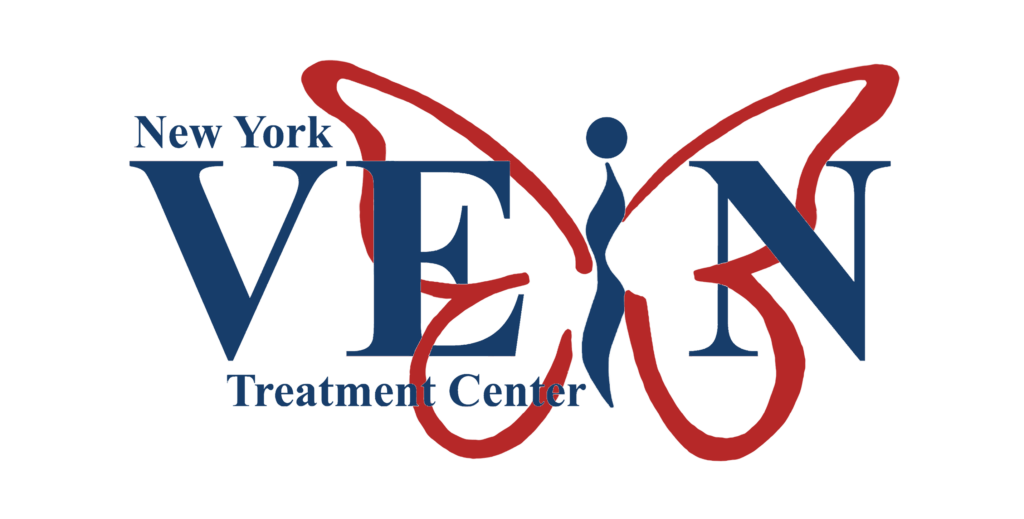Deep Vein Thrombosis (DVT) is a clot, called a thrombus, that forms in a deep vein. Without proper diagnosis and treatment, this clot can dislodge, traveling to other body parts, causing urgent and dangerous medical conditions.
At the New York Vein Treatment Center, we treat vein disorders, including DVT. That’s why we want to answer the question: What are the symptoms of a DVT in the legs?
What is DVT?
Deep Vein Thrombosis (DVT) is a clot that forms in a deep vein. These clots, called thrombus, often form in the legs, but can develop in the arm or other parts of your body.
Pulmonary Embolism (PE)
When part of a DVT dislodges and travels in the bloodstream, it’s called an embolus. When this embolus travels to the lungs and partially or fully blocks blood flow to the lung, it’s called a pulmonary embolism (PE).
Pulmonary embolisms are extremely dangerous and can be fatal. Symptoms of PE include the following:
- Chest pain
- Trouble breathing
- Coughing (including coughing up blood)
- Rapid heartbeat
- Sweating
- Fainting
If you believe you’ve developed PE, you must be seen by emergency care immediately.
Additional Complications
There are 2 additional complications arising from blood clots.
Chronic Venous Insufficiency
Chronic venous insufficiency may develop after a blood formation in the leg. This long-term condition causes blood to pool in the veins.
Post-thrombotic Syndrome
Post-thrombotic syndrome occurs when a blood clot in the leg damages the small valves in the veins, keeping them from pumping blood back to the heart.
What are the symptoms of a DVT in the legs?
It’s vital to note that DVT can exist without any symptoms. Those having DVT symptoms may experience the following:
- Pain and tenderness
- Leg swelling
- Redness and warmth
- Fatigue
- Heaviness in the leg
Since DVT symptoms mimic symptoms found with other medical conditions, it’s crucial to be diagnosed by a medical specialist.
What are the risk factors for DVT?
There are numerous risk factors associated with DVT:
- Family history of DVT
- Blood clotting disorders
- Being overweight or obese
- Being over 60
- Being sedentary for long periods
- Pregnancy
- Paralysis
Certain diseases and medical conditions are also risk factors:
- Previous blood clots
- Varicose veins
- Heart issues (heart failure or heart attack)
- Inflammatory bowel disease
- Lupus
- Cancer and specific cancer treatments
It’s also vital to note that birth control pills and hormone replacement therapies also put you at a higher risk of developing DVT.
How is DVT diagnosed?
Your medical provider will first assess your medical history and give you a physical exam. From there, additional tests may be performed.
Duplex Ultrasound
Duplex ultrasound uses high-frequency sound waves to examine blood flow and vein structure. It uses 2 modes of ultrasound: Doppler and B-mode. Doppler helps the provider see the direction and velocity of blood flow in the vein. B-mode creates an image of the vessel.
Duplex ultrasound is the most common test performed to identify DVT.
Blood Work
Blood work may be done to look for blood clotting and other issues.
What is the treatment for DVT?
Before a treatment plan is administered, your doctor will assess your specific case:
- Age
- Overall health
- Medical history
- Your symptoms
- Clot location
From there, a course of treatment will be prescribed. Here are some of the treatment options available for DVT.
Blood Thinners
Blood thinners are anticoagulant medications that disrupt the blood’s ability to clot. Common blood thinners include warfarin and heparin. Other anticoagulant medications include the following:
- Rivaroxaban
- Apixaban
- Dabigatran
- Enoxaparin
Common side effects are bleeding and bruising. Other side effects include the following:
- Blood in urine
- Bleeding with bowel movements
- Bloody nose
- Bleeding gums
- Vaginal bleeding
- Cuts that don’t stop bleeding
Thrombolysis
Thrombolysis uses clot-dissolving medications injected directly into the clot to help dissolve it.
Thrombectomy
Thrombectomy involves an angioplasty balloon catheter and a specialized device to break up the clot and remove it.
Inferior Vena Cava (IVC) Filter
The vena cava is a large vein that returns blood back to the heart. The inferior vena cava filter is placed in this vein to catch clots, keeping them from reaching the heart and lungs.
How is DVT prevented?
The biggest thing you can do to help prevent DVT is to stay active, especially when facing long periods of sitting or lying down. Try walking a little every hour to get the blood moving. When you can’t walk, try wiggling your toes and moving your ankles to increase blood flow.
Other things you can try include the following:
- Drink plenty of water.
- Drink less alcohol.
- Wear loose-fitting clothing.
- Wear compression stockings.
Experiencing symptoms of a DVT in the legs?
At the New York Vein Treatment Center, our venous specialists can properly diagnose and treat DVT. We’ll give you a personalized treatment plan to safely and effectively treat your clotting issues.
Contact us today if you’re experiencing symptoms of a DVT in your legs!

Dr. Lev Mark Khitin, a leading cardiovascular and thoracic surgeon, is the founder of the New York Vein Treatment Center. With almost 20 years of experience and over 20,000 successful vein procedures, he is a renowned expert in the diagnosis and treatment of venous disease. Dr. Khitin’s patient-centered approach and advanced surgical skills have consistently delivered excellent results, making him a prominent figure in the field.


